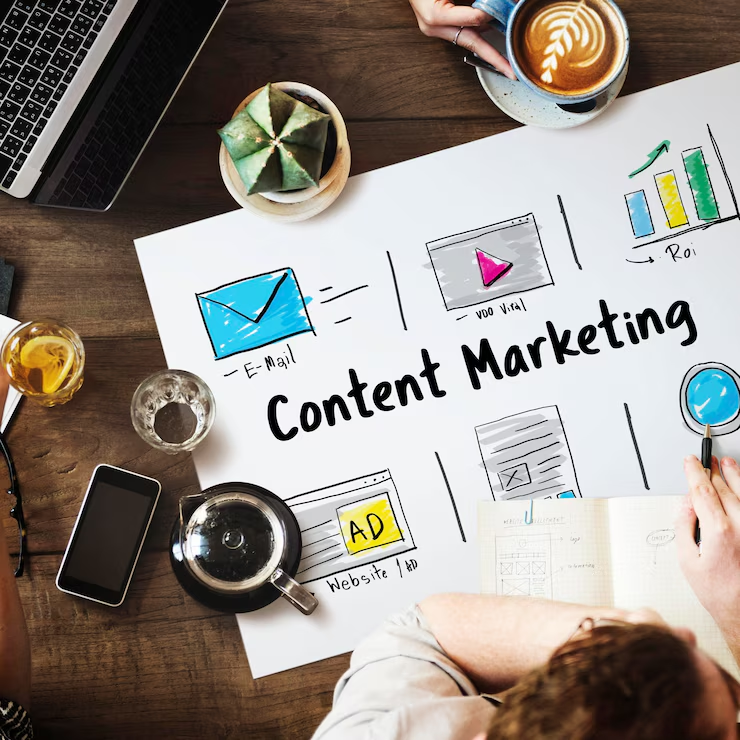Digital marketing, also known as online marketing, refers to promotional activities conducted through the internet and other digital channels to reach potential customers. Unlike traditional marketing methods such as print ads or billboards, digital marketing campaigns appear on devices like computers, smartphones, and tablets. These campaigns can take various forms, including online videos, display ads, search engine marketing, paid social ads, and social media posts.

Why is Digital Marketing Important?
In today’s digital age, online presence is crucial. More than three-quarters of Americans go online daily, with 43% accessing the internet multiple times a day and 26% almost constantly. These numbers are even higher for mobile internet users, with 89% going online daily and 31% almost constantly. This high internet usage presents a vast opportunity for marketers to reach their target audiences through digital channels.
Types of Digital Marketing
Search Engine Optimization (SEO): SEO is the art and science of enhancing web pages to make them attractive to search engines. This involves optimizing content quality, user engagement, mobile-friendliness, and the number and quality of inbound links. The ultimate goal is to rank on the first page of search engine results, making it easier for potential customers to find your products or services.
Content Marketing: This strategy focuses on creating and distributing valuable, relevant content to attract and engage a target audience. Content marketing includes blog posts, e-books, newsletters, videos, whitepapers, and infographics. The aim is to provide useful information that attracts leads and converts them into customers.
Social Media Marketing: This involves using social media platforms like Facebook, Twitter, Instagram, LinkedIn, and YouTube to promote products or services. It helps drive traffic, increase brand awareness, and engage with audiences through posts, comments, and shares.
Pay-Per-Click (PPC): PPC is a form of online advertising where advertisers pay a fee each time their ad is clicked. One of the most common types of PPC is search engine advertising, such as Google Ads, where ads appear at the top of search engine results based on an instant auction system.
Affiliate Marketing: In this model, affiliates promote a business’s products or services and earn a commission for each sale or lead they generate. It’s a revenue-sharing arrangement that benefits both the affiliate and the merchant.
Native Advertising: Native ads blend seamlessly with the content around them, making them less intrusive. They provide information or entertainment before any promotional content, ensuring that the advertising aspect is less obvious.
Influencer Marketing: This strategy involves partnering with influencers—individuals with large followings on social media or other platforms—to promote products or services. Influencers endorse products to their followers, leveraging their trust and reach.
Marketing Automation: Using software to automate marketing tasks, such as sending emails and managing social media posts, enhances efficiency and personalization. Marketing automation helps collect and analyze consumer data, design targeted campaigns, and send messages at optimal times.
Email Marketing: This involves sending promotional messages to a list of subscribers. Effective email marketing requires personalization, clear opt-in options, and a mix of transactional and promotional content. It’s a powerful tool for lead generation and customer engagement.
Mobile Marketing: Engaging with audiences on their mobile devices through SMS, MMS, app notifications, and mobile-optimized content is crucial. With 85% of Americans owning smartphones, mobile marketing ensures that your campaigns reach a broader audience.
Digital Marketing Strategies
A successful digital marketing strategy involves setting SMART goals (Specific, Measurable, Achievable, Relevant, and Timely), identifying your target audience, creating a budget, selecting appropriate digital marketing channels, and continuously refining your efforts based on data analysis.
B2B vs. B2C Digital Marketing
Digital marketing strategies vary between B2B (business-to-business) and B2C (business-to-consumer) markets. B2B marketing focuses on building relationships and providing logical, evidence-based content, while B2C marketing often appeals to emotions and aims for immediate responses. B2B sales cycles are typically longer and involve multiple decision-makers, whereas B2C transactions are quicker and often driven by individual consumers.
Benefits of Digital Marketing
Digital marketing offers several advantages over traditional marketing:
- Broad Geographic Reach: Online ads can reach a global audience without geographical limitations.
- Cost Efficiency: Digital marketing is generally more cost-effective, with lower overhead costs compared to traditional marketing methods.
- Quantifiable Results: Digital marketing allows for precise tracking of campaign performance, making it easier to measure success.
- Personalization: Digital marketing enables personalized communication with customers based on their behaviors and preferences.
- Enhanced Customer Engagement: Real-time interaction with customers through digital channels fosters stronger relationships and brand loyalty.
- Convenient Conversions: Digital marketing makes it easy for customers to take immediate action, whether it’s making a purchase or signing up for a newsletter.
Creating an Effective Digital Marketing Strategy
To develop a successful digital marketing strategy, follow these steps:
- Set SMART Goals: Define clear objectives that are specific, measurable, achievable, relevant, and timely.
- Identify Your Audience: Understand who your target audience is, their preferences, and where they spend their time online.
- Create a Budget: Allocate resources effectively based on your goals and the digital channels you plan to use.
- Select Digital Marketing Channels: Choose the right mix of channels, such as SEO, content marketing, social media, PPC, and email marketing, based on your target audience and objectives.
- Refine Your Efforts: Continuously analyze data from your campaigns to identify what works and what doesn’t. Use this information to improve future campaigns.
Conclusion
Digital marketing is an essential component of any modern business strategy. It offers unparalleled opportunities to connect with customers, personalize interactions, and measure success. By embracing digital marketing, businesses can unlock new growth potential and stay competitive in today’s digital landscape.





